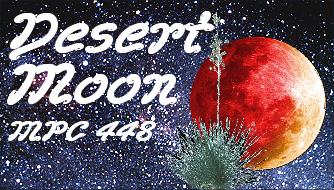Journey to the Umbra 2024:
The Total Solar Eclipse of
April 8, 2024
Solar eclipses for a particular continent are usually many years apart. For North America, we were lucky to have two solar eclipses occur just seven months apart. The annular solar eclipse of October 2023 was followed by the total solar eclipse of April 8, 2024. It was a double-header in the eclipse world.
Having successfully observed the annular in Midlands, TX, I started planning for the April total eclipse. The plan was to drive to the eclipse path so that a large amount of equipment could be available for the eclipse. While the path of the eclipse could be precisely computed, the weather would not be accurately predicted until a few days before the eclipse.
The first total solar eclipse I tried to observe was March 7, 1970. The Chicago Astronomical Society organized a bus trip to Fort Stewart in Savanah, GA. In a large open field, we watched the clouds roll in before totality. The sky became dark as the Moon's shadow sailed over us, but we did not see any of the eclipse. This eclipse was the twenty-seventh eclipse of Saros 139. Fifty-six years later, the thirtieth eclipse of Saros 139 would occur one month later and a little further southwest of the 1970 eclipse. I was not going to miss Saros 139 again.
For the 1970 eclipse, an experimental film from EG&G called Extended Range (XR) was going to be used for photographing the eclipse. While a normal Ektachrome film had three layers, each was only sensitive to only one primary color (red, green, blue) and they all had the same ISO speed. XR film had three panchromatic (sensitive to all colors) layers with ISO speeds of 0.004, 10 and 400 and it was developed with E4 (Ektachrome) chemistry. This would allow a single exposure to cover the brightness range from the chromosphere to the outer reaches of the corona of the eclipsed Sun. With the clouds obscuring the view, no photographs were obtained with XR.

|
| Satellite image of the cloud mass moving northward over the southern United States during the 1970 total solar eclipse. The center of the Moon's shadow is just northeast of Fort Stewart in this image as it moves northeast during the eclipse. Image credit: NASA ATS III |
The equipment to be used to observe the eclipse had been checked and tested during the preceeding months. Totality would last the longest in central Mexico, so the farther south you were located along the eclipse path in the United States the longer totality would last. In addition, climatological data indicated that Eagle Pass in southern Texas was most likely to be clear. Three sites were selected along the eclipse path starting with the closest in Eagle Pass being the prime site. The other two were further northeast in Gatesville, TX and Russellville, AR. This was about the maximum planned range for automobile travel.
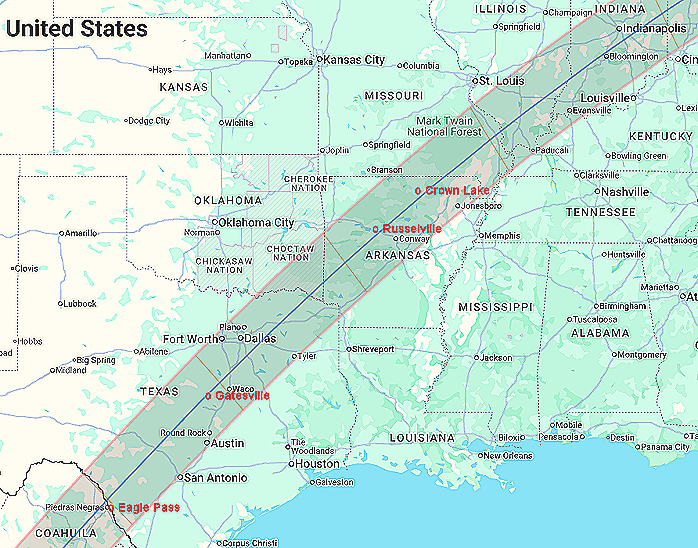
|
| The 2024 path of totality entered the United States in Eagle Pass, Texas, and headed northeastward traveling through Texas, Arkansas, Illinois, Indiana and into Ohio Proposed observing sites are shown in red. |
As the eclipse got closer, the weather began to look like it would be just the reverse of the climatological data. Southern Texas looked like it would be clouded out along with much of the track into Indiana. Northeastward from there the sky became clearer. To reach that area, it would be necessary to fly so most of the equipment would have to be left behind. This would be a desperate move, but might be necessary to see the eclipse.
Just four days before the eclipse, the cloud forecasts indicated that there would be a small clear area in north-central Arkansas. I decided that is where I would “make my stand”. If the weather changed, a new site could be selected in the newly predicted clear area on eclipse day if it was not too far. This would not be desireable anyway, since many other people might be driving that morning to get into the eclipse path.
The route from Las Cruces, New Mexico to Arkansas would take two days. With eclipse day falling on a Monday, it would be necessary to leave on Saturday morning to make it to the path of totality by Sunday afternoon. While my vehilce had made it to the annular eclipse and back with no problem, if a rental car broke down, the rental agency could get me another car to continue the thousand-mile journey while the original rental was repaired. No missing the eclipse due to a vehicular breakdown!
Most hotels were already booked along and near the eclipse path in Arkansas, southern Illinois and into Indiana. In north central Arkansas, the Crown Lake Resort in Horseshoe Bend was just nine miles northwest of the centerline and it had an opening. In addition, the nightly room rate was half of what the hotels were charging in that part of the state. I made a reservation for two days around the eclipse.
The rental car was picked up on Friday and the equipment was loaded into it. The weather continued to look good for northern Arkansas.
Saturday morning was clear as I started out on the two-day drive to the eclipse path. Starting in south-central New Mexico, I travelled through New Mexico to reach Interstate 40. Continuing east through the panhandle of Texas and into Oklahoma where I spent the night in El Reno, west of Oklahoma City. The weather forecast still looked good for Arkansas. Sunday finished the trip through Oklahoma and into Arkansas. Crown Lake Resort was far from an Interstate 40 and it took four hours on less-than-Interstate roads to reach it, traveling through a number of small towns.
Reaching the resort, I checked in and found my condo accommodation. I verified that the observing location I picked from the satellite images of the resort had a clear view of the sky. The site had a clear view of the sky and would make a good observing site.
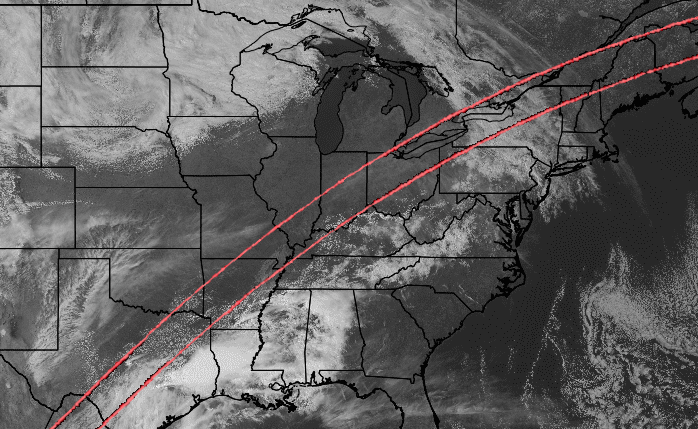
|
| Satellite image of the eastern United States two hours after the eclipse pass through this area. Crown Lake, Arkansas, was clear at eclipse time. The original prime site at Eagle Pass, Texas, had thick cloude during totality. |
Diffraction Limited’s MaxIm DL’s autosave sequencer allowed the creation of a sequence of exposures that would be automatically taken during totality. The sequencer could take up to 32 different exposure specifications and each group included a repeat count, allowing many exposures to be taken. The sequence was set up for totality at Eagle Pass, but totality would be shorter in Arkansas which was further from the maximum eclipse location in central Mexico. I loaded the autosave script into MaxIm and removed one 15-second exposure from the sequence.

|
| Bert programming the ETX for the eclipse. |
Eclipse morning dawned with high cirrus clouds covering the sky. The satellite loop showed an area of clear sky moving tin as the weather forecast had predicted, so I started setting up the equipment on the selected site on the shore of Crown Lake.
An ETX-125EC with a solar filter and a Canon Rebel XT camera was the first to be set up. The camera's infrared blocking filter had been removed for deep sky astrophotography. A replacement IR filter had been glued into the T-adapter in the optical train between the ETX and the camera. Unfortunately, it popped out when it was screwed into the ETX adapter. There was no way to glue it back in before the eclipse. I tried to tape it in place, but the tape would not stick. I finished the setup without the filter. The color balance would be incorrect, but it could be adjusted later. The ETX was tracking the Sun and the camera was set to be triggered by an interval timer to take an expose every two minutes. The sequence started shortly before first contact.
My trusty 6-inch f/4.5 Newtonian reflector that was used at almost every eclipse that I had attended was next. It was on an Orion SkyPro equatorial mount with a clock drive. At the prime focus was a Canon 6D camera connected to a laptop. Getting a good focus required the liveview function with 5x magnification giving a good focus on the edge of the Moon as it worked its way across the solar disc. This allowed me to focus the camera while looking at the larger image on the laptop screen since my eyes are not what they used to be for focusing through the viewfinder.
Mounted on the side of the telescope was Nikon Coolpix L810 camera. It was set to take a movie of the eclipse and it also acted as a counterweight to the Canon camera on the other side of the telescope tube. It runs on four AA batteries. I had bought some before leaving on the trip, but I could not find them, so I had to start the recording with the old batteries in the camera.
The final instrument was a Sigma 500 mm F/4 mirror telephoto lens with an Olympus OM-2 film camera on a photographic tripod. This was to take a few images of the eclipsed Sun on film. While this was very retro, it was to commemorate the 1970 eclipse by capturing some photographs of an eclipse in this Saros cycle on film.
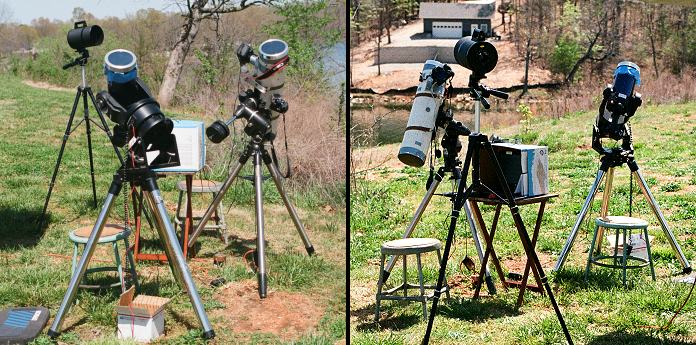
|
| The equipment used at this eclipse. The six-inch f/4.5 is on th right in the first image. The ETX-125EC in the middle and the 500mm f/4 mirror lens is at the upper left. |
As totality approached, final adjustments were made to the equipment. The six-inch was pointed at the crescent Sun. The Nikon Coolpix mounted on its side was pointed at a distant tree line. The movie recording was started and the focus was confirmed. I put a solar filter over the Coolpix and pointed it at the Sun.
With just a few minutes to totality, the solar filters were removed for the six-inch and Coolpix. The Canon’s liveview was started and I double checked the position of the Sun on the laptop screen. The Sun had drifted southeast and I used the slow-motion controls to bring it back westward. The I was unsure of the time, so I took the initial delay out of the MaxIm DL script and started it running. The camera started its second contact sequence of 1/1000 second images.
I went back to the car and picked up a pair of binoculars. Second contact had been observed before, but only through a camera viewfinder. Binoculars were much clearer. There was a very thin crescent of sun left. The Moon broke the crescent into a few individual arcs. Then the remaining arcs disappeared behind the Moon leaving the corona and a few prominences visible. Totality had started.
Next was a few shots with the 500 mm telephoto and the Olympus OM-2. I had taken film images of all the eclipses I had seen until 2017 and I wanted to take some film images of this eclipse before I went all digital. When I cranked the winder, I realized that I had not changed film from the previous day's shooting! I opened the camera and removed the used film. I ran to the car and got the roll of Kodak 400 print film that I was going to use for the eclipse. I loaded the film into the camera and started shooting. I ran through various exposures. Since this was a “fun” imaging, the exposure times were not recorded.
While I was taking the pictures, I noticed that the Canon had stopped taking images. The sequence had started way too early and had finished before the eclipse ended. I went over to the laptop and started the imaging script again. Any image was better than nothing.
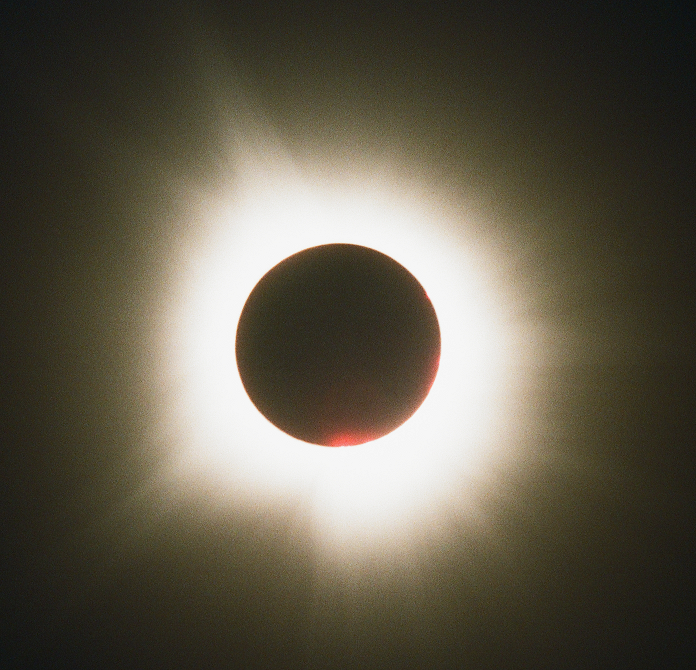
|
| The tripod-mounted Sigma 500 mm f/4 mirror lens and an Olympus OM-2 took this picture of the eclipsed Sun on Kodak Kodacolor Ultra Max 400 GC color negative film. |
Returning to the 500 mm, I checked the position of the Sun in the viewfinder and repositioned the eclipse near the center of the field of view. I continued taking pictures, changing the exposure time with each one.
As I was looking down at the exposure setting ring on the camera, I noticed it started getting brighter as the eclipse came to an end. I shifted to 1/1000 of a second exposure and took a couple more frames as the Sun started to reappear from behind to Moon.
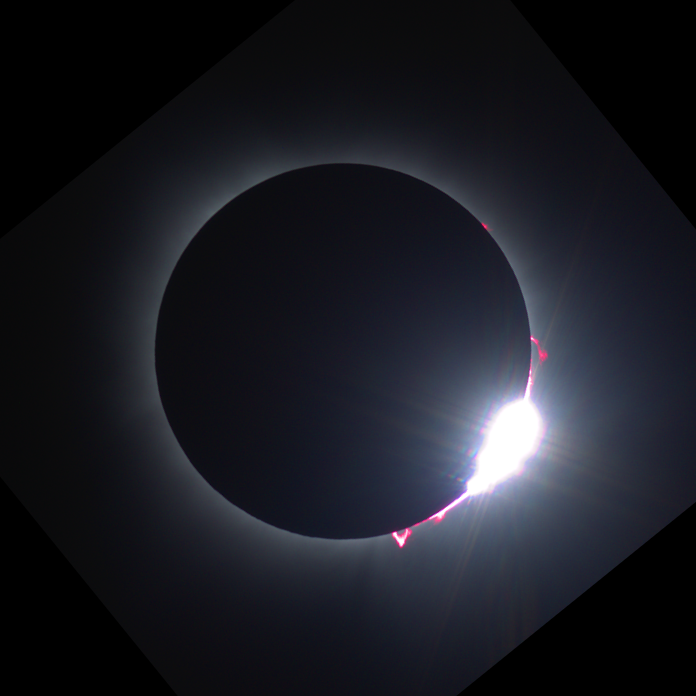
|
| The Sun begins to reappear as the Moon uncovers it. This image was taken just after third contact taken with the six-inch f/4.5. Exposure 1/250 second at ISO 100. North is up. |
As the crescent Sun expanded, I pointed the 500 mm away from the Sun so the camera would not be damaged. I put the solar filters back on the rest of the equipment. After months of planning and testing, I had managed to see the eclipse!
With totality over, the equipment that was used for that phase was closed down and stowed back in the car. Occassional images of the partial phases were taken through the Canon 6D as the Moon exited the Sun. Finally the Moon finished passing off to the east side of the Sun and the eclipse was over.
The remaining equipment was loaded into the car and returned to my condo. Looking at the results of the imaging, the Nikon Coolpix that was supposed to be shooting a movie of the eclipse had exhausted the old batteries before totality even started, so there was not going to be a video of the eclipse.
The partial phase images on the ETX were overexposed due to the missing filter. This was unfortunate, but the partial phases are not the most exciting part of the eeclipse and there were already many partial phase images of other eclipses were in the files.
Checking the images through the 6-inch/Canon 6D, the second contact images were lost since the sequence was started too early. Many of the totality images were identical. This was a mystery since there was a wide range of exposures programmed into the script. Loading the script into Maxim DL on the laptop, many of the ISO settings for the exposures had been set to Auto instead of 100. When the script was edited to remove a single 15 second exposure, the camera was not connected to the laptop. Because it did not see a camera that could set the ISO, MaxIm DL changed the ISO setting from ISO 100 (setting 1) to Auto (setting 0). This caused the camera to automatically increase the ISO setting as the exposure time was reduced. This resulted in many of the images looking the same. They were not bad images, just all identical-looking.
There were a few exposures in the sequence that had not been reset to auto-ISO and stayed at ISO 100. These provided images of the eclipse that were different than that obtained with the auto setting. These images showed the corona and prominences at different exposures, so this imaging was a success.
Returning home, the print film was sent out to The Darkroom in San Clemente, CA. Tracking the package on the USPS website, it went to California and then suddenly appeared in Philadelphia! They finally shipped it back to California where The Darkroom processed the film and provided scans. The pictures of the eclipse on film were good, reaching my goal of recording this eclipse on film.
While not everything went as planned (does it ever?), I got to see this eclipse under clear skies from a great location only eleven miles from the centerline and managed to get many images memorializing the event. It was a great adventure that was a great success!
Observing Location: 91° 44′ 43″.5 West, 36° 12′ 29″.3 North, 219.5 meters WGS-84
Here is a mosaic of images from this eclipse. Click on an image for a larger version:
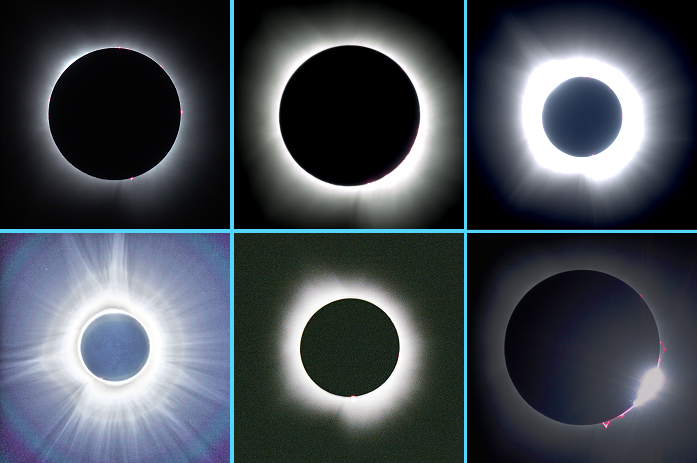
|
| Images of the Solar Eclipse. Image descriptions from top left: Inner corona just after second contact; Middle corona; Outer corona; High dynamic range combined image of the corona; Corona on film; and the diamond ring at third contact as totality ended. Click on an image to see a larger version. |
|
